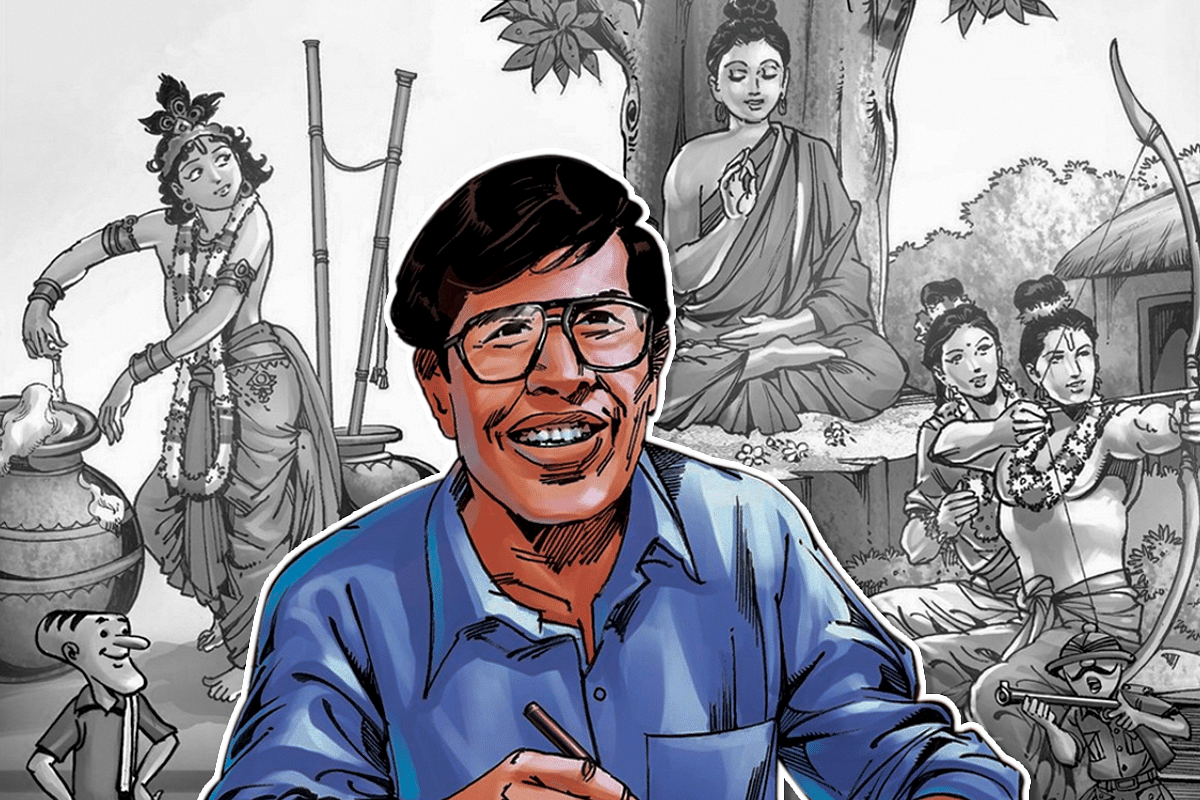
A Bharat Ratna For Anant Pai Because That Will Be A Celebration Of India’s History And Culture Itself
In a country like India, with its infinite diversity, Amar Chitra Katha became the means through which Indian children learnt of and experienced their cultural and spiritual unity in diversity.
Amar Chitra Katha was created by Anant Pai and on his 90th birth anniversary today here is a tribute to his brilliance.
Pained at the alarming cultural illiteracy exhibited by students in a television quiz show and also impressed by the way imported comics with Western themes like ‘The Phantom’ were winning the hearts of Indian children, Anant Pai launched ‘Amar Chitra Katha’ (ACK) in 1969.
‘The only comic books which are allowed inside the schools’ – was one of the many phrases that defined the Amar Chitra Katha (ACK) series. Today, they form an encyclopedia of Indian culture and history.
Anant Pai had a wonderful team of illustrators who worked on each of the issues with different styles. He also had a team to research the subject that was chosen.
In a country like India, with its infinite diversity, ACK became the means through which Indian children learnt of and experienced their cultural and spiritual unity in diversity.
The research that goes into production of each issue can be seen in the small descriptions that are given along with the comics. These descriptions are on the inside front cover in the old issues and on the back cover in the new ones.
Take for example the famous Tamil drama-poem Manonmaniam by Sundaram Pillai. ACK points out that the whole drama is a spiritual allegory.
It is through ACK that we, or at least this writer, came to know as a boy about Yellaprada Subbarao, the famous scientist; Khudiram Bose, the teenage martyr during our freedom struggle, Sunahshepa, the son of a sage who was adopted by Rishi Viswamitra, defying the birth-based Gotra concept.
It was in ACK — and not in any history textbook — that I learnt that Sant Guru Ravidas was the spiritual guide of the saint-queen, Mirabai.
I am sure hundreds and thousands of non-Tamil children would have felt the spiritual egalitarianism of Indian culture in the illustration of Thirupan Aazhwar — the marginalized bard — who was carried on the shoulders of the chief archaka of Sri Rangam into the temple. What a way to eradicate those diseases of the mind — casteism and untouchability!
Veer Shivaji and Dr Ambedkar came alive on the pages of ACK. The way ACK presented Shakuntala’s story marks a milestone in children’s literature in the world.
Uncle Pai, as he was fondly referred to, never considered ACK as trivial comics — he took enough and extreme care to ensure that the depiction and narrative matched the authentic sources as much as possible.
And then, there are also illustrations that are sublime — like that of Akbar being depicted as touching the feet of Mirabai in reverence. Though this does not have any basis in history, yet, it represented the civilisational spirit of India where the temporal power bows down before a woman’s devotion to the Supreme.
In fact, the ACK on Mirabai (1972) contains some of the most beautiful panels of Sri Krishna and Mirabai, illusrated by Yusuf Lien. Only in India could such a panel be presented in a children’s book and only a genius who understood the heart of India could publish such a book!
Anant Pai was not content merely with creating ACK. He launched Tinkle, a magazine for children and Partha, a magazine for teenagers. Unfortunately, the latter has stopped being published.
He also experimented with new forms of communication technology. He produced a video titled, ‘Ekam Sat’, which explains to Indian teenagers the Vedic concept of the Divine.
Uncle Pai showed that India’s recent generational cultural illiteracy — created by the colonial system and continued by the succeeding colonised minds — could be reversed through the innovative efforts of individuals outside the colonised ecosystem.
He did not work with state support or any institutional backing. Such an effort to reassert and self-discover a nation is astonishing and stands alone in the history of our post-colonial world.
Today ACK still carries the light lit by Uncle Pai. ACK reaches out not only with new titles but also with memes in the social media, which go on illustrating the cultural heritage of India — particularly from lesser-known aspects and forgotten pages.
Their recent publications on Sardar Patel, A P J Abdul Kalam and Thanjavur show that Uncle Pai’s mission continues in a sustained way.
Rightly, Uncle Pai should be considered as one of the builders of modern India — a very unique builder who connected the past with the present for the prosperity and inner richness of our future.
Such a person should be honoured by India, not because it would glorify him, for he was the classical Sthitha Prajna of Bhagvad Gita — doing his work with dedication, love and without expecting any rewards. He should be honoured because that shall be a blessing on us and our children.
In honouring Uncle Pai we honour all the memories of all our great men and women throughout the history from time immemorial.
Yes. ‘Bharat Ratna’ surely deserves Uncle Pai.